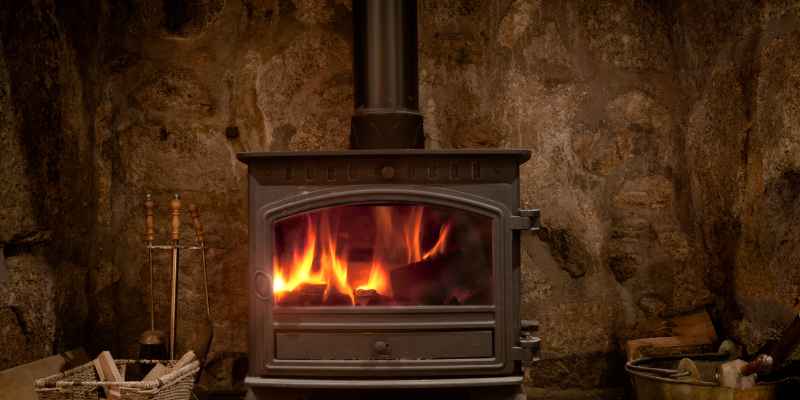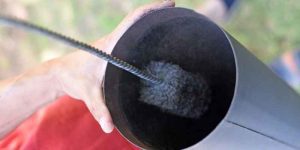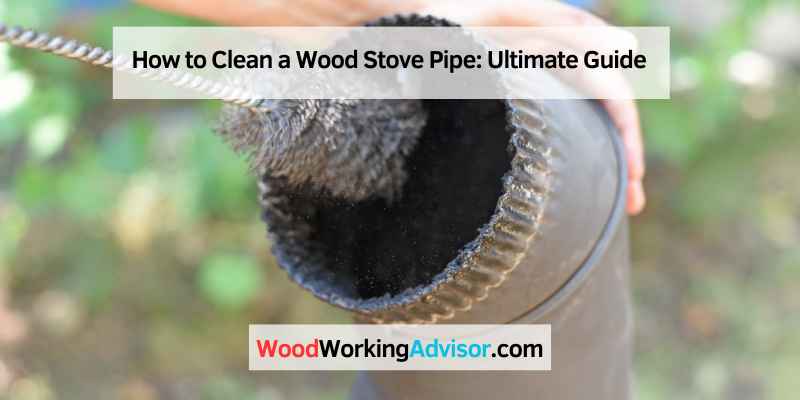To clean a wood stove pipe, use a long-handled wire brush to remove creosote buildup. Cleaning the stovepipe annually will prevent soot and creosote accumulation.
Wood stove pipes require regular cleaning to maintain their efficiency and safety. Creosote and soot buildup can create fire hazards and cause poor draft, leading to inefficient burning. Cleaning the wood stove pipe at least once a year is essential to prevent these issues.
In this guide, we will discuss the step-by-step process of cleaning a wood stove pipe effectively. Following these tips will help you maintain a safe and efficient wood stove system in your home.
Introduction To Wood Stove Pipe Cleaning
Learn how to clean a wood stove pipe with a long-handled wire brush, which effectively removes creosote buildup. Regular cleaning is essential to prevent issues like smoke filling the room or difficulties in starting and maintaining fires.
Why Is Cleaning A Wood Stove Pipe Important?
Regularly cleaning your wood stove pipe is crucial for maintaining the efficiency and safety of your wood-burning stove. Over time, creosote, soot, and debris can accumulate inside the pipe, restricting airflow and causing a variety of problems.
- Promotes proper ventilation: A clean wood stove pipe allows smoke and gases to exit your home efficiently, reducing the risk of carbon monoxide buildup.
- Prevents chimney fires: Creosote buildup is highly flammable and can ignite, leading to dangerous chimney fires that can damage your chimney or even your entire home.
- Improves energy efficiency: A clean pipe ensures better airflow and combustion, maximizing the heat output from your wood-burning stove and reducing fuel consumption.
- Extends the lifespan of your stove: Regular cleaning helps prevent corrosion and deterioration of the stovepipe, ensuring it lasts longer and performs optimally.
What Happens When The Wood Stove Pipe Is Not Cleaned Regularly?
When the wood stove pipe is not cleaned regularly, it can lead to a range of issues that affect both the performance and safety of your wood-burning stove.
- Reduced efficiency: Accumulated creosote and soot restrict airflow, making it harder for the fire to burn efficiently, resulting in decreased heat output and wasted fuel.
- Poor air quality: A dirty wood stove pipe can cause smoke and gases to build up inside your home, leading to poor air quality and potential health hazards.
- Increased risk of chimney fire: Creosote buildup is highly flammable and can ignite, causing a chimney fire that can quickly spread and cause extensive damage.
- Deterioration of the pipe: Excessive creosote can corrode and damage the interior lining of the stovepipe, leading to leaks and requiring costly repairs or replacement.
- Higher maintenance costs: Neglecting regular cleaning can result in more frequent repairs and maintenance for your wood-burning stove, adding to your overall expenses.
Signs That Indicate A Wood Stove Pipe Needs Cleaning
Campfire Odor In The Fireplace
If your fireplace emits a persistent campfire odor, it could indicate a buildup of creosote in the wood stove pipe, requiring immediate cleaning.
Odd Burning Of Fires
Unusual burning patterns, such as slow or erratic fires, can be a sign of restricted airflow due to a dirty stove pipe.
Difficulty In Starting And Maintaining A Fire
If you find it challenging to ignite a fire or struggle to keep it burning, the wood stove pipe may be clogged with creosote and soot, hindering proper ventilation.
Smoke Filling The Room
A significant indicator of a dirty wood stove pipe is when smoke from the fire fills the room instead of efficiently exiting through the chimney.
Blackened Fireplace Damper
Inspect the fireplace damper for blackened residue, which can indicate a need for cleaning the wood stove pipe to ensure proper functionality.
Oily Marks On Fireplace Walls
Presence of oily marks on the walls surrounding the fireplace suggests the buildup of creosote, indicating the need to clean the wood stove pipe.
Evidence Of Animals In The Chimney
If you discover any signs of animal activity or nesting materials in the chimney, it is crucial to clean the wood stove pipe to prevent potential blockages.
Frequency Of Cleaning A Wood Stove Pipe
Regular maintenance of your wood stove pipe is crucial to ensure efficient and safe operation. Soot and creosote buildup can pose fire hazards and reduce the effectiveness of your stove. Cleaning frequency will depend on usage but generally, annual cleaning is recommended to prevent issues.
Why Should Wood Stove Pipe Cleaning Be Done Annually?
An annual cleaning helps prevent fire hazards by removing creosote buildup, ensures optimal stove performance, and extends the lifespan of your wood stove pipe.
Comparison Between Wood Stove Chimneys And Regular Fireplace Chimneys
| Wood Stove Pipe | Regular Fireplace Chimney |
|---|---|
| Smaller scale cleaning process | Larger scale cleaning process |
| Easier to access and maintain | Might require professional cleaning |
Processes Involved In Cleaning A Wood Stove Pipe
- Use a long-handled wire brush to remove creosote buildup
- Sweep down the entire length of the flue pipe
- Clean out any debris that falls into the stove
- Reinstall baffles and cap once cleaning is complete
Methods Of Cleaning A Wood Stove Pipe
To clean a wood stove pipe, use a long-handled wire brush to remove creosote buildup. Annual cleaning is recommended to prevent odors, difficult fires, and smoke. Follow a simple process by sweeping the flue pipe’s length and removing any debris.
Avoid costly chimney cleaning services with this DIY maintenance routine.
Using A Long-handled Wire Brush
When cleaning a wood stove pipe, start by using a long-handled wire brush to remove any creosote buildup inside the pipe.
Make sure to wear protective gear and use the brush in a sweeping motion to scrub away the residue.
Scraping The Chimney With A Wire Chimney Brush
After using the wire brush on the stove pipe, scrub the chimney with a wire chimney brush to dislodge any remaining soot and debris.
Ensure that the brush reaches all corners and angles for a thorough cleaning.
Using A Flexible Rod/weedeater Head
For hard-to-reach areas, utilize a flexible rod or a weedeater head attachment to navigate through the twists and turns of the stove pipe.
This method helps in reaching inaccessible parts and ensures a comprehensive cleaning process.
Cleaning The Firebox
Don’t forget to clean the firebox of the wood stove as well. Remove any ashes and debris, as they can affect the efficiency of the stove.
Regular cleaning of the firebox is crucial for optimal performance.
Step-by-step Guide On Cleaning A Wood Stove Pipe
Cleaning the wood stove pipe is an essential part of maintaining a safe and efficient wood stove. A clean pipe reduces the risk of chimney fires and ensures that smoke and gases are properly vented. Follow this step-by-step guide on how to clean a wood stove pipe to keep your stove running smoothly.
Removing The Pipe
The first step in cleaning a wood stove pipe is to safely remove it from the stove. Allow the pipe to cool completely before disconnecting it from the stove and carefully remove it from the chimney.
Chimney Inspection
Inspect the chimney for any signs of damage or blockages. Look for creosote buildup, cracks, or debris that may hinder proper ventilation. Address any issues before proceeding with cleaning.
Vacuuming Debris
Use a high-powered vacuum to remove any loose debris, ash, or creosote from the interior of the pipe. Make sure to wear protective gear such as gloves and a mask to prevent exposure to harmful particles.
Installing Expandable Pipe
If necessary, consider installing an expandable pipe to replace any damaged sections. Ensure that the new pipe fits securely and is properly sealed to prevent any leaks.
Assembling The Chimney
Reassemble the chimney by securely attaching the cleaned pipe back to the stove. Double-check all connections to ensure a tight and secure fit.
Cleaning The Firebox
While cleaning the pipe, also take the time to clean the firebox and stove interior. Remove ash and debris to maintain optimal combustion and heat efficiency.
Tips And Best Practices For Wood Stove Pipe Cleaning

Cleaning a wood stove pipe is crucial to ensure its proper functioning and prevent the risk of fire hazards. Regular cleaning not only removes creosote and soot buildup but also increases the efficiency of your wood stove. To help you maintain a clean and safe wood stove pipe, here are some helpful tips and best practices:
Using A Wood Moisture Meter
A wood moisture meter is a valuable tool for wood stove owners. It measures the moisture content of the wood used as fuel, allowing you to gauge its effectiveness and prevent excessive creosote buildup. To use a wood moisture meter effectively:
- Select a well-seasoned, dry piece of wood from your fuel supply.
- Insert the prongs of the moisture meter into the wood, making sure they penetrate to the center.
- Read the moisture level displayed on the meter. Ideally, the moisture content should be around 20% or lower.
- If the moisture content is higher, let the wood dry further before using it in your wood stove.
- By regularly checking the moisture content of your firewood, you can prevent excessive creosote buildup and ensure optimal heat production.
Protective Measures During Cleaning
When cleaning a wood stove pipe, it is essential to take the necessary protective measures to ensure your safety. Here are some best practices to follow:
- Wear heat-resistant gloves to protect your hands from the high temperatures of the stove and pipe.
- Use safety goggles to shield your eyes from any debris or particles that may be dislodged during the cleaning process.
- Consider wearing a face mask to prevent inhalation of soot or other harmful particles.
- Ensure proper ventilation in the area where you are cleaning to avoid the buildup of smoke or fumes.
Safety Precautions For Handling The Stove Pipe
Handling the stove pipe requires caution to prevent injuries and damage. Keep these safety precautions in mind:
- Avoid cleaning the stove pipe when it is hot. Allow it to cool down completely before starting the cleaning process.
- Place a drop cloth or sheet underneath the pipe to catch any soot or debris that may fall during cleaning.
- Use a long-handled wire brush or chimney brush specifically designed for stove pipes to remove creosote buildup.
- Work the brush in an up and down motion, ensuring thorough cleaning of the entire length of the pipe.
- Inspect the stove pipe for any signs of damage or corrosion while cleaning. If you notice any issues, consult a professional for repairs or replacement.
By following these tips and best practices, you can ensure effective cleaning of your wood stove pipe and maintain a safe and efficient heating system in your home.

Frequently Asked Questions For How To Clean A Wood Stove Pipe
What Can I Use To Clean My Wood Stove Pipe?
To clean your wood stove pipe, use a long-handled wire brush to remove creosote buildup efficiently. Regular cleaning is essential to prevent chimney and stove issues. For thorough cleaning, consider professional services to ensure safe and effective results. Regular maintenance will extend the lifespan of your wood stove.
How Often Should I Clean Wood Stove Pipe?
Clean your wood stove pipe annually to prevent creosote and soot buildup. Use a long-handled wire brush to remove residue. Regular cleaning ensures proper functioning and reduces the risk of chimney fires.
How Do I Know If My Wood Stove Chimney Needs Cleaning?
To determine if your wood stove chimney needs cleaning, look for these signs: 1. Campfire odor in your fireplace 2. Difficulties starting and maintaining a fire 3. Room filling with smoke when fireplace is used 4. Blackened fireplace damper 5. Oily marks on fireplace walls 6.
Evidence of animals in the chimney. Remember, regular cleaning should be done annually.
How Do You Clean A Chimney Flue On A Wood Stove?
To clean a chimney flue on a wood stove, use a long-handled wire brush to remove creosote buildup. Pass the brush down the flue, allowing the debris to fall into the stove. Be sure to scoop out any accumulation and reinstall the cap and baffles once finished.
Conclusion
Cleaning a wood stove pipe is crucial for maintaining a safe and efficient heating system. By following the proper steps and using the right tools, like wire brushes and vacuuming debris, you can easily keep your chimney free from creosote and soot buildup.
Regular cleaning will ensure your wood stove pipe functions optimally and minimizes the risk of chimney fires. If you’re looking for a cost-effective and practical way to maintain your wood stove pipe, following these cleaning methods will help you ensure a warm and safe environment in the long run.


